#Drone Image & Film Australia Melbourne
Text
Real Estate Drone Photography & Videography Services in Melbourne

Real Estate drone photography can help enhance residential & commercial property features. Aerial photography with drones is imaginative and attractive. If you are looking for Drone Videography Melbourne, we have a wide variety of options for all of your real estate video needs. Contact Us: https://droneifa.com.au/
0 notes
Photo

Polar Visions Amplitude reviewing -
John Wiese - Deviate From Balance
Released on 15 June 2015 by Gilgongo Records
Reviewed format: CD album
Connected listening - there are various ways to order a selection of John Wiese’s further discography. The Helicopter mail-order stocks various John Wiese releases as well as Sissy Spacek releases and releases by by John Wiese in collaboration with associates, you can find it here: https://helicopter.storenvy.com/collections/924921-john-wiese
Several solo releases by John Wiese are also available on physical and digital format from his Bandcamp page here: https://johnwiese.bandcamp.com
Many releases on Gilgongo Records are available on physical format through their mail-order store here: https://gilgongorecords.storenvy.com
After looking at one of Sissy Spacek’s recent new albums Featureless Thermal Equilibrium in the previous Polar Visions Amplitude it’s time today for the first of two follow-up reviews in which in this case we’re focussing first on one of John Wiese’s past solo albums, Deviate From Balance. Released back in 2015 on both a 2 LP vinyl package as well as a CD version on James Fella’s label Gilgongo Records our look is on the CD version which features the packed 79 minute album in full and what a collection of pieces it is. While the Sissy Spacek album showcases John Wiese’s talent in mixing Grindcore aggression with monolithic Noise screeches as well as maxing out the energy throughout, Deviate From Balance showcases John’s more restrained side in a collection of 10 tracks encompassing mostly live recorded compositions and improvisations that are leaning more towards intense choppy sound collages and noisy electro-acoustic interplay of acoustic and electric instrumentation with John’s electronics with a more conceptual edge to them. However while some of the titles of the 10 pieces suggest a somewhat philosophical or technical meaning behind these pieces, listening to these reveals a much more playful and raw sense of composition and performances from John and all musicians and artists involved in this album. Whilst John’s sound can be related to Free Improvisation, his rapid-fire editing and manipulation of sonic material on this album is much more complex and dazzling than many other artists and carries John’s signature knack for surprise, high frequency distortion crunches as well as shifting and abusing lo-fi sound recording equipment and electronics in as many ways as possible, almost as if they turn into crumbling fragile rocks. Disintegrating broken sound and dadaist absurdist humour is a recurring theme in John’s sound, making for an album that is much more enjoyable than overly academic contemporary Tape Music can be at times. Besides John’s sonics the involved musicians on this album are definitely an important element that adds many rich colours to the 10 pieces, featuring musicians like guitar virtuoso Oren Ambarchi, violin artist Jon Rose, sampling expert David Shea and drum machine musician Ikue Mori as well as many others. Before we’re diving deep into the 10 tracks on Deviate From Balance, let’s have a look at the packaging design of the CD version. The CD comes in a neat glossy oversized gatefold sleeve showcasing John Wiese’s minimalist design, artwork as well as a very colourful artist photo of John by Martin Escalante on the back. In terms of artwork I do like the photo-collages and art pieces on the inside of the gatefold a bit more than the cover this time as while the cover does highlight the general collaged, choppy nature of the album well in a visual manner, its subdued grayscale grainy images aren’t as striking as John Wiese’s other album covers but still, it’s a decent cover and the typography is quite stylish and repeats on the spine in a similar manner. The aforementioned imagery on the inside of the gatefold showcases both grayscale abstract art in the form of archaeological artefact style fragments on the left panel as well as a film roll like photo collage of a rather disturbed looking lady blowing up a balloon. The abstract images are a bit similar to the album cover though with darker and more distinct contrast but the photo collage also adds another good visual reference to the packaging regarding the tracks themselves in that balloon like squealing and screeching can be heard on some of the pieces and it also seems to refer to the album’s quite off the wall type of abstract humour. The left panel additionally features all album credits neatly laid out so you can find out all about the involved artists and recording locations plus sources. The CD itself comes in a convenient little black envelope with plastic protection and features a more LP like label design featuring simply the artist name, album title and Gilgongo label logo, somewhat similar to a Japanese mini-LP replica package. Now that we’ve looked at the package, let’s pop in the CD and dig in.
Deviate From Balance starts with Wind Changed Direction which is one of the most atmospheric pieces on the album. The piece blends organ like drone, chopped up distorted recordings of what sounds like children’s voices, machinery as well as other Industrial noises together to form a quite surreal mysterious soundscape. Quite like the title suggests the music sounds quite like you’re floating through the clouds right after the wind has changed direction. The drone feels both calming but also a notch ominous whilst the auto-panned chops of sound are both vaguely abstract and at times recognisable with John varying between distorted and resonant shards of crunchy sound and cleaner metallic elements. The voice samples hint somewhat at sonified memories, they sound like fragments from the past, conversations or event you might remember from childhood though the actual words are unrecognizable. This first piece is definitely one of the most straight-forward compositions on here in terms of structure with the drone both introducing and rounding off the piece as in both cases it eventually fades into the background. A quite lush start of the album. Following piece 356 S. Mission Rd continues the soundscape like approach but in a more ominous manner sounding quite like a cross of dark sounding orchestral music samples with strange hollow metallic resonances and washy shifting noises. The metallic resonances bring plenty of subdued Industrial shine to the piece but the aforementioned orchestral samples are what draws me into this piece the most as the screechy dissonant strings combined with ever so slightly differently timed horn crescendo suggest an ever apparent danger which is getting closer but just like in an abstract nightmare is stuck in a loop with the danger never reaching further than a certain indiscernible point. The shifting noise elements add some rawness to the piece which suggests some kind of turntable manipulations going on in the piece, a lovely brooding collage piece this is. Segmenting Process For Language, the next piece, is where things start to get more chaotic and free-wheeling though still very much controlled. The track featuring a live performance recorded at East Brunswick Club in Melbourne, Australia consists of wild and inspired mixtures of saxophone, (junk) objects, percussion, drums, guitar and noise as the musicians move into always differing “segments” made up of shards of sound, wildly swirling melodies, chords and tones. This does make for quite some literal clashes of sound but rather than being one of the more random sounding Free Improv performances the sections of interplay follow a much more recognisable structure in that certain droning tones as well as feedback lays somewhat of a base underneath the bursts of sonic mayhem. Whilst there are a whole lot of things happening in this recording I would like to name a few particularly enjoyable bits. These include the short bursts of squelchy synth swirls, resonant ground vibrating feedback laden noise, the hilarious goofy but still playful wordless vocalisations spat out by the musicians but also the at times disturbing dissonant chords which are formed and culminate in an absurdly, almost 50’s Horror film soundtrack like waves of organ droning at the ending of the piece after which we can hear the only applause that could be fit in on the tightly edited CD. An inventive juxtaposition of out of the blue musical absurdism with the more dadaist lightning strike like approach of collage based Harsh Noise carrying John’s seal of quality. The next track Superstitious does match its title rather well in terms of the sounds within and it’s the most Noise focussed piece on Deviate From Balance though still more along the lines of a layered soundscape. After the instrumental interplay of Segmenting Process For Language we’re back to a more noticeably composed piece which moves through various phases emitting a definite ambience of superstition through somewhat disturbing concrete sounds, noise and tones. Its beginning featuring chopped and quite heavily scrambled recordings of a scared woman wailing as well as various other waves of distorted sound and tone overtime moves to the climax of the piece which is an extended section of the aforementioned noise from by a nicely low end grounded stream of screechy sound featuring especially piercing high frequency sound manipulations quite like some kind of dystopian alien machinery, though your interpretation might definitely be much different. Regardless of how you interpret it, the piercing noise does give off quite an intense feeling of dread and fear and while the sounds used in the piece are sometimes somewhat recognisable, like dirt like crumbling sounds, coffee cups, car related sounds etc., again they’re manipulated and structured in such shifting and distorted manners that they feel like sudden waves of mind imagery than things you can really grab onto. The finale of the piece in which John frequency manipulates a continuous tone is quite gripping too and Superstitious as a whole sounds quite like both a physical and mind gripping piece. Cafe OTO is the track that follows and it’s obviously a live recording that was made at Cafe OTO. Moving back to the more improvisation based style of collaborative group performances that John Wiese has done together with other musicians this piece has a more continuous flow of sonic events and instrumental interplay and a generally might lighter edge to it than some of the other pieces. Especially the percussion blended with effect manipulations and saxophone performances are particularly good on here with percussion clattering, clinking, jumping around the room in quite hilarious surprising manners moving from crystal like tinkling to shells and wooden percussion whilst the saxes wildly swirling melody lines and screeches form sweet tonal abstraction that are wild but not going overboard and staying well in tune with the other elements of the performances. The “spat” out vocalisations are quite matching with the saxophone performance and whilst somewhat more subtle for most of the recording, there’s also some tasty, albeit less abrasive crashes of objects near the end of the recording. Again, John Wiese’s talent in highly abstract but always varied and uncompromising electronics and instrumental performances combined with the excellent inspired energy of all musicians that appears in his group performances shines through with the fun and details in the layers created making this suitable for many repeat listens. The following track Battery Instruments (Stereo) does work quite like an extension of the sounds from the Cafe OTO recording, though in a bit more minimalistic fashion being made up of mostly small, clicky and quite sounds. A collage of instrument, objects, electronics as well as short vocal bursts the piece puts the freely moving aspect of John Wiese’s group pieces into more of microscopic lowercase territory. It’s the shortest piece of the album at 2:12 minutes and works as kind of transition from Cafe OTO to the quite abrasive walkman Noise collage piece Memaloose Walkman, showcasing various crackling, scraping, spiky sonic details, a mysterious subdued drone as well as some quite tasteful bass string scratchings all panned quite widely (as this was originally a multi-channel piece). A sweet short piece this one. The aforementioned piece Memaloose Walkman then follows and it’s quite straight-forward in nature consisting of a mono tape collage of various recordings of gunshots. Besides splices and perhaps a bit of pitch adjustment there’s not much manipulation added to this but as a Noise piece it’s quite effective letting you hear the different swishing phased textures of shots from various guns as well as some bits of talk and music in between with a layer of crunchy saturation on top of everything. Simple but effective. Afterwards Dramatic Accessories continues within the Noise territory as a piece of quite a lot of instrument / object and especially turntable abuse featuring quite a lot of bassy and wild distorted screeches mixed with chopped recordings all presented through some crazy panning. One that will especially please harsh heads, within Dramatic Accessories there are various sections in which John and the other artists involved use all kinds of methods to create a variety of sounds ranging from the shifting kind of turntable warble, clicks, grating washes of distortion, chunks of feedback, amp hiss and metallic ringing. However whilst there are a lot of distorted sonic events happening within this piece, there is some sense of dynamics within however, created by the wild panning as well as shifting the phase and using some of the room acoustics and feedback of equipment to create some loud / softer / loud sections leaving some headroom for the sounds to not fully max out and become a bit overblown. The garbled object and instrument chops are clattering around often but strange distorted disturbing recordings of voices are also thrown in the mix making for an at times frightening but thrilling ride of unpredictable sounds. One element that is recurring throughout the wildly fluttering barrages of different sounds are certain grounded tones that bring forth some kind go base for all sounds to lean on as they continue changing in at times rapid manners. All in all Dramatic Accessories is another enjoyable sonic ride on Deviate From Balance in which rich and uncompromising textures are brought out in memorable ways through some fine inspired performances from all people involved. Solitaire follows, which is one of the two longest and final pieces on Deviate From Balance, at 11:15 minutes. In terms of approach the piece is somewhat similar to Dramatic Accessories but with the difference that rather than using vinyl, tape is being used here as one of the elements that create the various sounds within the piece. Solitaire follows a more continuous structure than other pieces on Deviate From Balance in that it’s mostly based on a set of repeating patterns within it's structure acting a bit like the compositional and performance equivalent of mechanical processes. Whereas Dramatic Accessories featured experiments with both clean and distorted sounds, Solitaire moves more into a quite crunchy rough direction featuring shards of chopped up instrument and music recordings, junk objects, voices as well a various especially percussive and resonant concrete sounds that ever continue to change in form. These repetitive patterns do give some kind of rhythmic drive to the piece but change often enough to not become sampler like and are more akin warbled broken tapes as the recordings are mercilessly abused through speed manipulations and ever increasing distortion. This is combined with a constant shift of stereo phase, through which on headphones you get the idea that the shards of sound are flying over your head and are forming 3D shapes in between your ears. A great listening experience which even works as the distortion gets quite murky and harsh nearing the end of the piece. Whilst the pattern style, on the fly pitch warbles and crunching noises carries on throughout, it’s great how some depth is slowly forming near the end of the piece, in which soft ticking percussive bits are being scattered between out ears and rimshot like ticking sounds are added for nice clean percussive accents. A very fluid piece in terms of progression and sound work which shows that whilst John Wiese’s solo and band works might at times sound very free-flowing and chaotic, he’s always got quite some noticeable control and focus within every piece, inspired and always different. Final piece Segmenting Process (Oregon) is indeed somewhat related to the earlier Segmenting Process For Language although in the case of this recording the segmenting of the several parts of the piece is even more clear. Being the longest piece on Deviate From Balance at 21:45 minutes the piece is also one of the most introspective and “organized” sounding tracks on the album as in here we can find the by now familiar mixture of acoustic, electric instrumentation with both electronic sounds and manipulations but also a more restrained approach to the Noise elements John Wiese has explored in various ways in most tracks before this one. Rather than almost overtaking the non-electronic instrumentation either through loudness or sharp (harsh) frequencies, the Noise is more in tune with the instrumentation as being a part of a blend of various sonic elements. This is also helped by the fact that with the larger group setting featuring brass, percussions, drums and more the piece required a larger venue to be performed which gives the piece some welcome acoustic space, adding some room ambience and keeps the piece nicely dynamic. Sounding most similar in approach to Electroacoustic Improvisation the pieces segments blending vibrant instrumental performances which vary from fluttering percussive tones, noises as well as more drone focussed falling and rising tones with crackling, noisy, humming, distorted, sample based and glitchy electronics sound quite like the piece is based on a mixture of dreams. Like a sonic interpretation of a dream world the piece moves from segment to segment with all of them featuring somewhat recognisable sounds like the instruments themselves or voices mixed with shaped abstract noises but everything carries some kind of mystery within it, which is especially caused by the somewhat unnerving textures created by the brass instruments within the performance. The absurdist humour element is still apparent within the piece however with at times goofy squeaky noises, drum kit hits, tinkling bells and other pointy bits of abstract sound keeping things nicely playful and light but still powerful as always. The flow of the piece also helps to keep things captivating and interesting throughout as its length might take some listeners a bit to get into it but with so many different events happening throughout there’s never any idleness in here. And with this last piece I’m getting into the conclusion of this review of John Wiese’s Deviate From Balance. I award this album a Polar Visions Amplitude of 85 dB, recommending you to definitely check out this album. Deviate From Balance showcases both John Wiese’s compositional and performance talents through a varied selection of recordings in which you can hear John’s approach in various settings ranging from surreal sound collages, Noise infused instrumental improvisations to rough tape manipulation and Electroacoustic Improvisation. Never resorting to mere academic musical studies John Wiese’s pieces on Deviate From Balance keep hitting the ears and mind in excellent and inspiring manners and will be a great discovery for fans of free spirited contemporary music, both analog and digital based sound collage works, (Harsh) Noise fans as well as anyone into inspired improvised music and will be a great addition to the collection of fans of John Wiese and Sissy Spacek.
Deviate From Balance is available on CD from Gligongo Records mail-order store here: https://gilgongorecords.storenvy.com/products/20648396-john-wiese-deviate-from-balance-cd-gggr-077
#polar visions amplitude#album review#john wiese#deviate from balance#15 june#2015#gilgongo records#cd album#sound collage#musique concrete#noise#free improvisation#electroacoustic improvisation#unsettling#disturbing#playful#absurdist#humorous#introspective#PVA
2 notes
·
View notes
Video
youtube
World Windows 2020
19 April 2020
Today’s Windows:
Visit Lucas Creek, Auckland, New Zealand with @onereyofstarlight
Visit Christchurch, New Zealand with @onereyofstarlight
Visit the Great Ocean Road, Port Campbell Coast, Victoria, Australia with me.
Thank you wonderful peeps for participating. If you have some favourite places you would like to share while we are all stuck at home, simply post some photos and tag #WorldWindows2020 (tagging me also helps so I can add your Window to the list). Remember, your backyard is exotic to people on the other side of the world (like me).
Today I’m going to throw many, many photos of ocean and rock at you. In fact, the day you travel the length of the western half of the Great Ocean Road, otherwise known as the Port Campbell Coast, you will be so sick of rock that the world famous Twelve Apostles will just be meh :D
So starting from where we left off last time travelling west from Apollo Bay, you wander through some more temperate rainforest, through some rolling hills and then things start to change. As the road turns north-west, you come up against a sandstone coast that is subject to the full power of the most violent ocean on the planet.
The majority of the weather that hits our southern coasts comes from the west to south-west. Consequently, any coast facing in that direction takes a pounding. The eastern side of the Great Ocean Road still has open ocean to contend with, but it is a little more protected. The western side is not.
Check out the satellite image and zoom in to see all the rocky and wobbly coastline.

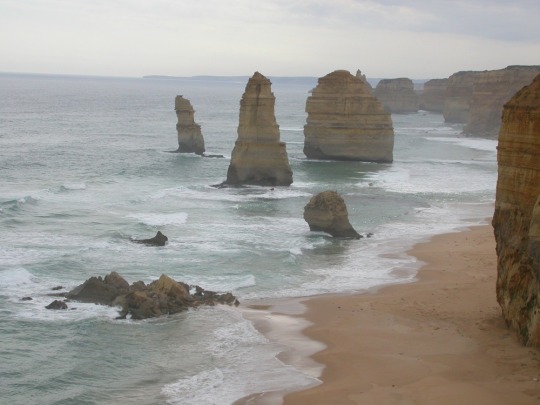

Hey, look, it is the Twelve Apostles as you will never see them in the tourist brochures. This is because I was there in the middle of winder. It was a trip to Melbourne for Hubby’s birthday and since he managed to get born in the depths of the coldest parts of the year in one of the coldest capital cities, yay, we get to visit in winter.
But at least it makes for moody lighting.
It should also be noted that there are not twelve apostles. They keep falling down. I don’t know if there was originally twelve, but I’ve only counted eight and I know at least one has fallen down in my lifetime.

There are a large number of spots to stop and look at on the side of the road.

This is Island Arch. (EDIT: Um, while looking up the London Bridge collapse, I discovered that this collapsed in 2009. It is now two islands. This photo is from 2007.) It is a part of a group of formations that include the Razorback, Mutton Bird Island (yes, it has a colony, I think) and Loch Arde Gorge. Loch Arde Gorge has been used for film making several times in the past, and in the actual past it was the sight of a shipwreck. The video at the top of this post was me on the beach in Loch Arde Gorge, with my kids (hence the interruption part way through) in 2015. Just some wave action. It is a very moody beach.
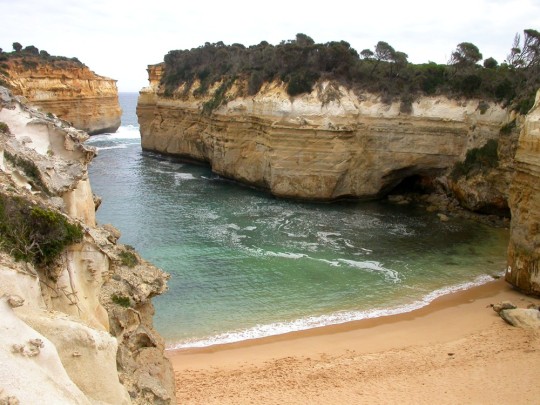
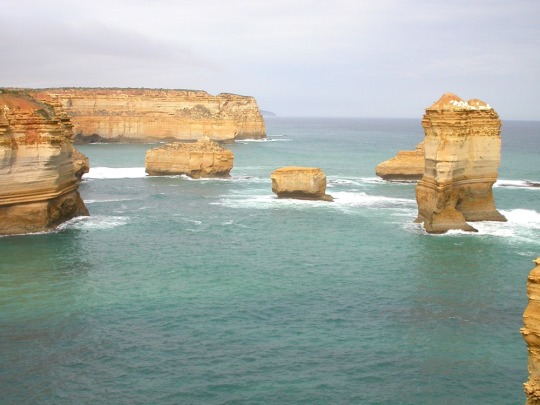
Back in March 2007, just outside Port Campbell we encountered something else along side that road.



Port Campbell is one of a few towns on the stretch of road. I want to actually stay there one day. It looks like a fascinating place to explore, but we usually drive straight through as we view the Great Ocean Road in transit, rather than a destination.

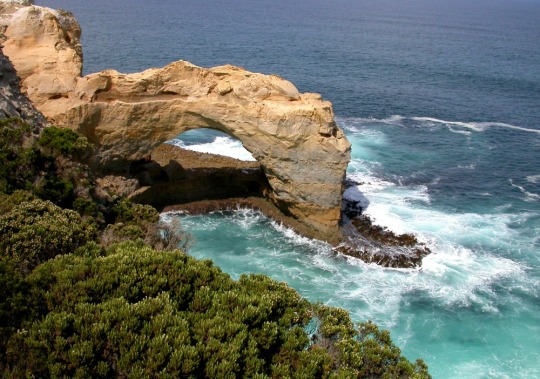
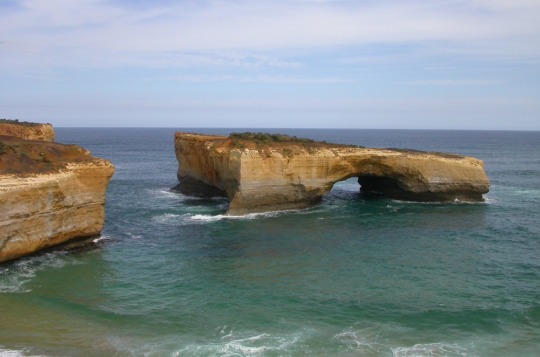
This is the remains of the London Bridge rock formation. It fell down.
Here is a Wikipedia article on it. I did manage to see it as a teenager. It collapsed in January 1990. I think I saw it in about 1986.
The last thing to see before you make it to Warrnambool is the Bay of Islands, which is lovely, but I don’t seem to have a great shot of it.

So here is someone else’s drone footage :D
youtube
I hope you enjoyed this World Window ::hugs you all:: Thanks for reading and watching :D
Nutty
(this is about 700kms from my backyard)
7 notes
·
View notes
Text
Friday-Sunday, 10-12 July
Friday
Did a few more small tasks in the morning but during the afternoon, we went for a drive with the intention of doing a couple of short walks advertised in one of the local brochures. It is surprisingly easy to get to places like Noojee (much closer than I imagined), but again, the dearth of adequate signage and the abundance of unreliable and confusing signage had us heading into unexpected detours and back-tracks on several occasions. Our plan was to do a 3-4 click walk to the Ada Tree, but we were unable to locate the start of the walk, so we travelled a lot of kilometres until we found the Ada Tree itself – only to find the whole area was closed. I think it had to do with the 15 kilometre social distancing rule. Certainly, apart from us, there was nobody within 15 (probably 50) kilometres of us. For those who may not know, the Ada Tree is thought to be the biggest tree in Victoria. It is very old and we have actually seen it before without being overawed, but by the time we found it, it was time to head back home – this time via Moe and the Freeway.
Saturday
We did a bit of shopping in the morning, mainly to redress the implications of Melbourne’s lockdown. When we left home, we expected to return for a few days some 3 weeks later. With this in mind, we chose to leave a number of items (mainly the roof-rack and all the items we expected to carry in it during the rest of our travels) in our storage bay in Burwood, intending to collect them before setting off to more remote places. Alas, we won’t be risking a return to Melbourne to collect them for fear of not being able to leave again so we have had to purchase a few things to compensate for our inability to retrieve our gear from Burwood. The main things we needed was a new set of bog-mats (called recovery boards around here) and a few tie-down straps to attach things to the roof-bars rather than using the cargo nets over the roof-rack.
We also arranged to have a minor repair done as we leave Warragul next Friday. There is a slight leak from our water inlet that could possibly be fixed by me by simply tightening a plastic fitting with a spanner – but the plastic looks very suss to me and if it disintegrated when I tightened it, we would have no fresh water until it was replaced. It is getting progressively worse and we don’t want to head too far from a good water supply until we know it is all secure. Also, since putting the two spare wheels on the back of the car, our reversing camera is hidden and useless. The wheels also prevent me using the overhead camera to connect up the van so we have arranged to have the reversing camera repositioned so it is between the wheels and over the ball on the drawbar – that will be done on Wednesday arvo. It won’t resolve our inability to see much when reverse-parking but will help a little. When we are back in Melbourne, we will simply remove the left-hand spare and parking should be fine – and when we have the caravan connected, it won’t matter much anyway – especially because we avoid reversing as much as possible with the van connected.
We came back to the van after our shopping expedition and had lunch before going for a drive not too far from where we went a couple of days ago – roughly in the direction of Noojee but not so far. A lot of the area was forested and it was a really lovely drive. We found the Nangara Reserve and the Kurnai Trail and did a couple of walks – one longish, the other shorter – through the forest. Both were really great, walking around a former quarry with lots of lush ferns, frogs and fungi in towering trees, then later following a creek in slightly more open country with quite a few birds perched high in dead trees. We would have loved to explore a bit more in the area, but by then it was getting dark and we decided to return to the van, calling in at Ginny’s Fish and Chip shop in Drouin (recommended by the manager of our caravan park) for some exceptionally generous and tasty dinner. A really wonderful afternoon of exploration – all the more interesting because the weatherman got it wrong again. The BOM has predicted rain every day this week, but we have had a few cold damp days, but with little more than morning fogs and occasional misty areas when driving in the clouds on some of the higher roads – but virtually no rain.
Sunday, 12 July
The weatherman did a better job today. It started raining, just a bit more than mist, around 7am and it has been patchy ever since – clear skies, sunny periods, wispy clouds and a few short showers. We have been in the van most of the day, often with the air conditioner on to keep us warm, and enjoying the sound of the rain on the roof every now and then. It has a wintry feel (it is mid-winter in 3 days’ time after all!) but it’s very cosy and snug hiding out inside our cubby.
One really important thing we achieved in the afternoon was to get our new drone working. At one time, we were really opposed to drones because we saw other people with them making nuisances of themselves, particularly overseas. In Armenia, we had an ethereal, almost spiritual, experience in an ancient ruined church when our wonderful guide sang a love song in her native tongue in the centre of the church with the stone walls echoing back and surrounding us with wonderful bell-like sound – it was a truly unique and very beautiful experience. Utterly divine – almost literally. Then we went outside and almost got bombed by this guy flying a big noisy drone in the churchyard. It really spoiled the whole ecstatic experience for us – very disappointing and it set us against drones for several years.
Having recently seen a few films where images from a drone added a lot to the impact, we decided to swallow our sensitivities and buy a little one and try it out for ourselves. We went for a modestly priced one rather than splashing 10 or 15 grand on a supersonic amphibious version with night vision, all terrain and underwater capability and a red and yellow stylised ‘S’ on a blue flag. I worked on it for quite a few hours on and off, updating the firmware (several times), charging (and recharging) batteries, reading dozens of pages of Chinglese/Arabic User Manual and continually getting stuck when it said to press the non-existent ‘Connect’ button on the aircraft to connect to, and activate the controller. Interestingly, when Heather and I worked through the same process together, the whole thing worked without ever getting to that point – it simply connected automatically, so we took it outside and it worked. All we did was to take off and land it. The rules about drones in Australia are much stricter than those overseas and we decided not to do any more than that until we were out in the Never-never which is really what we bought it for. As to the hi-res photos and video promised by the drone, you will simply have to wait until we are ‘out there’ and can experiment much more fully.
1 note
·
View note
Text
Liam Young's Planet City could tackle climate change by housing 10 billion people in a single metropolis
The entire population of the earth could live in a giant sustainable city occupying a fraction of the earth's surface, freeing the rest of the world for rewilding and the return of stolen lands, according to a new movie by architect Liam Young.
Young's fictional Planet City movie proposes a hyper-dense, self-sufficient metropolis housing 10 billion people.
Built according to the principles of the circular economy, it could be built on 0.02 per cent of the planetary surface, taking up an area "roughly the size of an average US state".
Panorama of Planet City
Young is the latest architect to suggest a design solution for the entire planet, following the "Masterplanet" proposal for a global masterplan by Bjarke Ingels Group and Winy Maas of MVRDV's call for architects to design new planets to help understand how to solve problems on earth.
Young's animated short film provocatively explores how "centuries of colonisation, globalisation and never-ending economic extraction and expansionism" could be reversed to solve climate change and the exploitation of both natural and human resources.
The film was commissioned by the National Gallery of Victoria for the NGV Triennial, which opened in Melbourne, Australia last month.
Food would be grown in vertical orchards
"Planet City is a speculative narrative of what could happen if we were to radically reverse this planetary sprawl," Young told Dezeen.
"What if we reached a global consensus to retreat from our vast network of cities and entangled supply chains into one hyper-dense metropolis housing the entire population of the earth?"
"If we were to reorganise our world at the scale of our densest cities then Planet City could actually occupy as little as 0.02 per cent of the earth, [which is] roughly the size of an average US state," he said.
Planet City would be built of recycled materials
"Planet City is a fiction shaped like a city," he added. "It doesn’t pretend to be an executable proposal."
The idea stems from the Half Earth concept developed by biologist Edward O Wilson, which proposes that mass extinction can be averted by dedicating half of the surface of the earth to nature.
"The byproduct of this global park, however, is the necessity to redesign the realities of the present-day planetary city we all occupy," Young said.
"It is a microcosm of the planet that will afford us the space to rewild and return almost the entirety of the world to a global-scaled wilderness."
The proposal is based entirely on existing technologies
Young highlighted the differences between his approach to that of Masterplanet, a recent proposal by architect Bjarke Ingels Group that treats the world as a design problem that requires planet-sized solutions.
"The imposition of singular visions by starchitects just repeats so many of the mistakes that have got us into this situation in the first place," said Young, who is an architect and film director based in Los Angeles.
Vertical solar fields would provide power
"Such proposals are a continuation of the colonialist project that has already masterplanned the planet in its own image," he added.
"Plans of this scale have historically perpetuated forms of exclusion and reinforced existing systems of power. Most of these projects rarely engage with these root causes of climate change and, in fact, enable them."
The sustainably designed Planet City would accommodate 10 billion people, which is the projected population of the earth in 2050. People would live in "residential mountains" constructed from recycled materials with food grown in "indoor mega-farms" and vertical orchards.
The ground between buildings would be occupied by mega-farms
The city, which would operate as a closed-loop and generate no waste, would contain 221,367 square kilometres of buildings up to 165 storeys tall and 4,311,543, 982 bicycles. Power would come from 49,445,671,570 solar panels while 2357 algae farms would filter pollution and provide supplementary food.
"Planet City utilises only technologies that are either already available or currently in development and has been designed in consultation with a global network of scientists, theorists and economists," said Young.
"Through this process of grounded speculation Young sets out to demonstrate that climate change mitigation across the world is no longer a technological problem, but rather an ideological one, rooted in culture and politics."
The 15-minute film centres around a non-stop planetary festival that moves through the city, linking up celebrations held by different cultures throughout the year.
Algae lakes would act as filter beds while growing food
Young collaborated with creatives including Ane Crabtree, the costume designer for The Handmaid's Tale, geoengineer Holly Jean Buck, science-fiction writer Kim Stanley Robinson and indigenous Australian writer and director Ryan Griffen.
Young, who describes himself as a "speculative architect," was a keynote speaker at Dezeen's 2019 Dezeen Day conference in London, where he called on architects to increase their influence by applying their skills to popular digital media such as video games instead of designing "rich houses for rich people".
People would live in residential mountains up to 165 storeys high
Young, who is co-founder of urban futures think tank Tomorrows Thoughts Today and research studio Unknown Fields Division, also featured in Dezeen's 2018 movie Elevation, which explores how drones could transform architecture and cities.
He previously directed movies including In The Robot Skies, which was the first film to be shot entirely using drones.
National Gallery of Victoria Triennial runs from 19 December 2020 to 18 April 2021 at NGV International, 180 St Kilda Road, Melbourne, Australia. For details of more architecture and design events, visit Dezeen Events Guide.
The post Liam Young's Planet City could tackle climate change by housing 10 billion people in a single metropolis appeared first on Dezeen.
0 notes
Text
Travel 2020: Forecasting the new decade of travel was one of the largest travel industry consumer reports conducted with a sample of almost 20,000 Australian travellers giving insight into the direction of domestic and international travel. Initiatied by Luxury Escapes, research firm, Nature, undertook the mammoth task of surveying its member base of 3.2 million.
“We know that Australians love to travel, and this research confirms it, showing Australians are planning to travel even more in the coming decade, with frequent domestic travel and an annual trip overseas, increasingly to celebrate life’s milestones, to relax and recharge, or to blend work with a holiday – all themes that we saw from this research and that marry up with what we’re experiencing” Luxury Escapes CEO Cameron Holland says. “We’re seeing more and more the importance of providing relevant experiences through personalisation whilst also inspiring travellers to visit destinations they never previously considered thanks to our sophisticated algorithms.”
The report found that Aussies love to travel, with one in two respondents
spending at least $2,000 a year on domestic travel and three in ten spending more than $10,000 a year on international travel.

(Canada’s Wonderland Amusement Park) Jay Thaker / Getty Images
7 Key Trends:
International destinations to visit in 2020: Canada (21%), USA (19%), Italy (17%), England (15%) and Greece (14%)
The connected trip: 1 in 4 travellers want to be connected 24/7 on holidays, 14% go off the grid
Transformational travel: Top interests to travel are food (59%), local culture (55%), history (52%) and walking (32%)
No bad time to book a holiday: Five nights most popular length of trip, 28% spend more than $10k on international travel
Conscious travel: 1 in 4 Australians would travel for a wellness retreat, 13% would try ‘voluntourism’
Travel innovations: Smart hotel rooms (36%), facial recognition at airport (29%), robot companions (9%) and 1 in 5 want to try space travel
Hyperspeed travel and space tourism: Innovations set to turn science fiction into travel reality – Virgin galactic, Uber Air Taxis
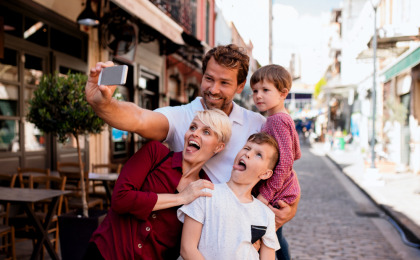
How Australians plan to travel in 2020:
4 in 10 Australian travellers expect to take at least 2 short trips within Australia next year
6 in 10 Australian travellers expect to take at least 1 long trip within Australia next year
2 in 10 Australian travellers expect to take an overseas trip (of at least 1 week) within the next 12 months
1 in 4 Australian travellers prefer to be connected throughout their holiday, rather than go off-grid
7 in 10 Australian travellers completely leave work behind when they’re on holiday
“Tech can remove friction as we travel, providing a more seamless travel experience. Apps like TripIt, Rome2Rio and GoldenCircle remove stress from the physical travel experience, but we will also see innovations in virtual reality. Mindfulness apps potentially reduce our desire for physical relocation to instead journeying inside, while augmented reality will serve up even richer, digilogue experiences as we encounter physical reality armed with digital lenses.”
– Anders Sorman-Nilsson, Futurist
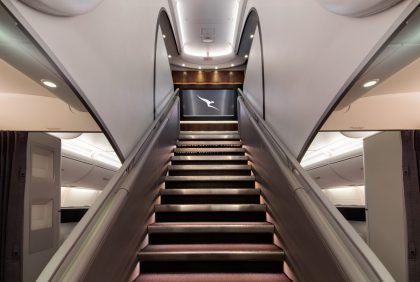
What Australians spend on travel:
1 in 2 Australian travellers spend at least $2,000 per year on Australian trips
$10k or more – 28%
$6-$10k – 8%
$4-$6k – 25%
$3-$4k – 5%
$2-$3k – 3%
3 in 10 overseas travellers typically spend more than $10k per year on their trips
(Qantas Airbus 380 – First class cabin and onboard lounge) / Qantas Airways

Holiday themes Australians are most interested in:
Food – 59%
Local culture – 55%
History – 52%
Walking / trekking – 32%
Winery / distillery / brewery – 31%
Fashion / shopping – 29%
Theme parks – 27%
Architecture – 25%
Driving – 24%
Music / festivals – 22%
“There is a heightened craving for authenticity and a strong desire to peel back and reveal the layers of local culture that may have been shrouded by generic tourism. There is a fundamental need to reconnect with one’s self, the community, and the world at large and to create experiences that are real, fulfilling and enriching. The shift from developed destinations, manufactured experiences, lavishness and opulence has moved to authentic, local, regional and crafted. True luxury travel has changed from extravagant to experiential.”
– Anna Guillan AM, Australia Consultant at Kerzner International

Holiday events Australians would travel for:
Birthday – 50%
Anniversary – 42%
Wedding – 39%
Reunion – 33%
Life / retirement – 32%
Mystery travel – 25%
Wellness retreat – 24%
Concerts / festivals – 24%
Engagement – 18%
Birth of a child – 16%
“We’re going to see a continued rise of immersive travel – getting under the skin of a destination. rather than just ticking it off your bucket list. Travellers are seeking more local connection – they want to live like a local and have those insider experiences through customised tours and private itineraries.”
– Sonia Pilovska, Head of Tours, Luxury Escapes
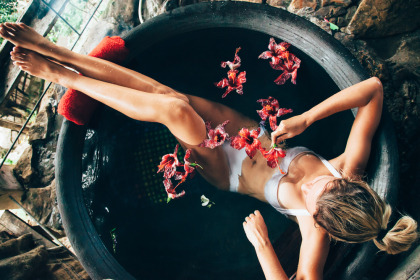
How Australians indulge when on holidays:
Fancy restaurants – 43%
Room upgrade – 32%
Massages – 32%
Special shopping purchases – 29%
High end dining experiences – 27%
Private tours – 25%
Spa days or treatments – 23%
Flight upgrade – 22%
Bucket list experiences – 21%
Airport lounge access – 19%
“Luxury isn’t all about starched tablecloths or marble bathrooms, rather it’s about the shared experience. This can come at any rate or price, but at the premium end of the market the experience is offered from a luxury ‘base camp’, with all the comforts of a luxury stay but with connections to community and the natural environment and opportunities for guests to learn and positively contribute.”
–James Bailie, founder Bailie Lodges

Travel inventions Australians are most interested in:
Smart hotel rooms – 36%
Facial recognition tech to expedite customs / airport – 29%
Smart luggage – 24%
Green airlines – 23%
Jet lag pill / cure – 22%
Hyperloop and fast speed travel – 22%
Space travel – 18%
Jetpack travel – 14%
Uber Chopper / drone taxis – 14%
Virtual reality – 14%
“As long-haul plane flights get even longer, airlines are studying how to reduce the impact of jet lag. Lighting systems can be used to help passengers adjust to their destination time zone, as can meals and meal timing. Airlines that incorporate the latest research for adjusting to jet lag and reducing travel fatigue on ultra long-haul flights will have a competitive advantage.”
– Dr David Cunnington, sleep physician and co-director of the Melbourne Sleep Disorders Centre
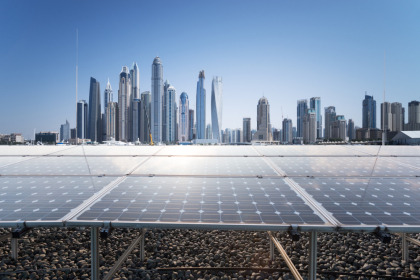
“Everything will be hyper-local and energy-conscious, we will have lower tolerance for high- carbon impact extravagances. Things like vegan food itineraries, non-religious meditation and mindfulness retreats and artisan fashion will all become travel inclusions in the coming decade.”
Simon Westcott, CEO Luxe City Guides
Click below to read more reviews and news on (New articles daily):
DINING | RECIPES | FILM | TV | MUSIC | FASHION | HEALTH & FITNESS | TECHNOLOGY | FAMILY & KIDS ENTERTAINMENT | TRAVEL | MOTORING | RESEARCH | PEOPLE & BUSINESS IN THE COMMUNITY | SOCIAL SCENE & EVENTS
INTERVIEWS & PODCASTS
7 key trends in Australian travel over the next decade #travel #qantas #research #auspol #marketresearch #consumerresearch #marketing Travel 2020: Forecasting the new decade of travel was one of the largest travel industry consumer reports conducted with a sample of almost 20,000 Australian travellers giving insight into the direction of domestic and international travel.
#australian travel trends 2019#australian travel trends 2020#Hospitality Industry Report Australia#market research travel industry australia#popular travel destinations#Travel ideas Australia#travel statistics australian travel#travels trends in australia
0 notes
Text
Fighting the common fate of humans: to better life and beat death
by Cathal D. O'Connell
This piece is republished with permission from Millenials Strike Back, the 56th edition of Griffith Review. Selected pieces consist of extracts, or long reads in which Generation Y writers address the issues that define and concern them.


The oldest surviving great work of literature tells the story of a Sumerian king, Gilgamesh, whose historical equivalent may have ruled the city of Uruk some time between 2800 and 2500 BC.
A hero of superhuman strength, Gilgamesh becomes instilled with existential dread after witnessing the death of his friend, and travels the Earth in search of a cure for mortality.
Twice the cure slips through his fingers and he learns the futility of fighting the common fate of man.
Merging with machines
Transhumanism is the idea that we can transcend our biological limits, by merging with machines. The idea was popularised by the renowned technoprophet Ray Kurzweil (now a director of engineering at Google), who came to public attention in the 1990s with a string of astute predictions about technology.
In his 1990 book, The Age of Intelligent Machines (MIT Press), Kurzweil predicted that a computer would beat the world’s best chess player by the year 2000. It happened in 1997.
He also foresaw the explosive growth of the internet, along with the advent of wearable technology, drone warfare and the automated translation of language. Kurzweil’s most famous prediction is what he calls “the singularity” – the emergence of an artificial super-intelligence, triggering runaway technological growth – which he foresees happening somewhere around 2045.
In some sense, the merger of humans and machines has already begun. Bionic implants, such as the cochlear implant, use electrical impulses orchestrated by computer chips to communicate with the brain, and so restore lost senses.
At St Vincent’s Hospital and the University of Melbourne, my colleagues are developing other ways to tap into neuronal activity, thereby giving people natural control of a robotic hand.
These cases involve sending simple signals between a piece of hardware and the brain. To truly merge minds and machines, however, we need some way to send thoughts and memories.
In 2011, scientists at the University of Southern California in Los Angeles took the first step towards this when they implanted rats with a computer chip that worked as a kind of external hard drive for the brain.
First the rats learned a particular skill, pulling a sequence of levers to gain a reward. The silicon implant listened in as that new memory was encoded in the brain’s hippocampus region, and recorded the pattern of electrical signals it detected.
Next the rats were induced to forget the skill, by giving them a drug that impaired the hippocampus. The silicon implant then took over, firing a bunch of electrical signals to mimic the pattern it had recorded during training.
Amazingly, the rats remembered the skill – the electrical signals from the chip were essentially replaying the memory, in a crude version of that scene in The Matrix where Keanu Reeves learns (downloads) kung-fu.
youtube
The Matrix: I know king fu.
Again, the potential roadblock: the brain may be more different from a computer than people such as Kurzweil appreciate. As Nicolas Rougier, a computer scientist at Inria (the French Institute for Research in Computer Science and Automation), argues, the brain itself needs the complex sensory input of the body in order to function properly.
Separate the brain from that input and things start to go awry pretty quickly. Hence sensory deprivation is used as a form of torture. Even if artificial intelligence is achieved, that does not mean our brains will be able to integrate with it.
Whatever happens at the singularity (if it ever occurs), Kurzweil, now aged 68, wants to be around to see it. His Fantastic Voyage: Live Long Enough to Live Forever (Rodale Books, 2004) is a guidebook for extending life in the hope of seeing the longevity revolution. In it he details his dietary practices, and outlines some of the 200 supplements he takes daily.
Failing that, he has a plan B.
Freezing death
The central idea of cryonics is to preserve the body after death in the hope that, one day, future civilisations will have the ability (and the desire) to reanimate the dead.
Both Kurzweil and de Grey, along with about 1,500 others (including, apparently, Britney Spears), are signed up to be cryopreserved by Alcor Life Extension Foundation in Arizona.
Offhand, the idea seems crackpot. Even in daily experience, you know that freezing changes stuff: you can tell a strawberry that’s been frozen. Taste, and especially texture, change unmistakably. The problem is that when the strawberry cells freeze, they fill with ice crystals. The ice rips them apart, essentially turning them to mush.
That’s why Alcor don’t freeze you; they turn you to glass.
After you die, your body is drained of blood and replaced with a special cryogenic mixture of antifreeze and preservatives. When cooled, the liquid turns to a glassy state, but without forming dangerous crystals.
You are placed in a giant thermos flask of liquid nitrogen and cooled to -196℃, cold enough to effectively stop biological time. There you can stay without changing, for a year or a century, until science discovers the cure for whatever caused your demise.
“People don’t understand cryonics,” says Alcor president Max More in a YouTube tour of his facility. “They think it’s this strange thing we do to dead people, rather than understanding it really is an extension of emergency medicine.”
youtube
Alcor president Max More.
The idea may not be as crackpot as it sounds. Similar cryopreservation techniques are already being used to preserve human embryos used in fertility treatments.
“There are people walking around today who have been cryopreserved,” More continues. “They were just embryos at the time.”
One proof of concept, of sorts, was reported by cryogenics expert Greg Fahy of 21st Century Medicine (a privately funded cryonics research lab) in 2009.
Fahy’s team removed a rabbit kidney, vitrified it, and reimplanted into the rabbit as its only working kidney. Amazingly, the rabbit survived, if only for nine days.
More recently, a new technique developed by Fahy enabled the perfect preservation of a rabbit brain though vitrification and storage at -196℃. After rewarming, advanced 3D imaging revealed that the rabbit’s “connectome” – that is, the connections between neurons – was undisturbed.
Unfortunately, the chemicals used for the new technique are toxic, but the work does raise the hope of some future method that may achieve the same degree of preservation with more friendly substances.
That said, preserving structure does not necessarily preserve function. Our thoughts and memories are not just coded in the physical connections between neurons, but also in the strength of those connections – coded somehow in the folding of proteins.
That’s why the most remarkable cryonics work to date may be that performed at Alcor in 2015, when scientists managed to glassify a tiny worm for two weeks, and then return it to life with its memory intact.
Now, while the worm has only 302 neurons, you have more than 100 billion, and while the worm has 5,000 neuron-to-neuron connections you have at least 100 trillion. So there’s some way to go, but there’s certainly hope.
In Australia, a new not-for-profit, Southern Cryonics, is planning to open the first cryonics facility in the Southern Hemisphere.
“Eventually, medicine will be able to keep people healthy indefinitely,” Southern Cryonics spokesperson and secretary Matt Fisher tells me in a phonecall.
“I want to see the other side of that transition. I want to live in a world where everyone can be healthy for as long as they want. And I want everyone I know and care about to have that opportunity as well.”
To get Southern Cryonics off the ground, ten founding members have each put in A$50,000, entitling them to a cryonic preservation for themselves or a person of their choice. Given that the company is not-for-profit, Fisher has no financial incentive to campaign for it. He simply believes in it.
“I’d really like to see [cryonic preservation] become the most common choice for internment across Australia,” he says.
Fisher admits there is no proof yet that cryopreservation works. The question is not about what is possible today, he says. It’s about what may be possible in the future.
Cathal D. O'Connell is the Centre Manager, BioFab3D (St Vincent's Hospital) at the University of Melbourne.
Top image: Johnny Depp as Dr. Will Caster in the 2014 Warner Bros. Pictures / Summit Entertainment film “Transcendence”.
This article was originally published on The Conversation.
12 notes
·
View notes
Text
When choosing where to have a funeral your choices have now grown.
Restaurants, bars, reception centres, wineries, gardens, sports clubs, private homes the choices are now only limited by your imagination.
Funerals have always traditionally been held in churches however as society becomes more secular it would appear that many are putting great thought into the meaning and relevance of the funeral and naturally where it should be held. Since the 1960s funeral homes had become an alternative to the church and whilst many families still opted for misters or priests, the funeral didn’t seem to have the church like feel that the traditional church service did. At the same time, many churches would not allow the coffin to be opened within the church in order for families to say their last goodbyes, The funeral home provided greater flexibility.
#gallery-0-9 { margin: auto; } #gallery-0-9 .gallery-item { float: left; margin-top: 10px; text-align: center; width: 50%; } #gallery-0-9 img { border: 2px solid #cfcfcf; } #gallery-0-9 .gallery-caption { margin-left: 0; } /* see gallery_shortcode() in wp-includes/media.php */
Dalywaters Estate, Mornington
West Beach Bathers Pavilion
From the 1980-s funeral homes began to offer simple refreshment services, typically tea, coffee sandwiches etc, the type of food you may have received in a church hall. Indeed some funeral homes around Australia began to offer licencing options. This was seen as quite a provocative move and created much discussion, but move forward a few decades and licensed venues are now almost seen as a prerequisite for many mourners.
The 90s began to see technology take hold. Where once music options may have been an organist or piano and hymns, more contemporary music options were becoming more common. Filming and live streaming of funerals was now available and starting to appear in many funeral homes. Simple framed pictures were now being replaced by full-blown audiovisual productions.
Technology has provided many additional opportunities for families, but the rate of technological change has been a double-edged sword. The cost of maintaining the latest equipment has been burdensome and expensive for many funeral homes, who were not geared for this.
Enter the function venues, facilities which were often idle, not having any daytime or weekday events, many of which have relished at the opportunity of doing either funerals, memorial services or wakes. The coffin once seen as almost taboo to have anywhere else other than a church or funeral home is now often accepted into these venues without any concern. Perhaps this reflects the changing way in which the community now sees funeral service and greater comfort when services are held in places with more meaning and relevance to mourners.
#gallery-0-10 { margin: auto; } #gallery-0-10 .gallery-item { float: left; margin-top: 10px; text-align: center; width: 50%; } #gallery-0-10 img { border: 2px solid #cfcfcf; } #gallery-0-10 .gallery-caption { margin-left: 0; } /* see gallery_shortcode() in wp-includes/media.php */
The Garden House, Royal Botanical Gardenss
Elwood Bathers
Most Melbourne Crematoriums have now undergone significant refurbishment, installing state of the art audiovisual equipment, refreshment lounges and large commercial kitchens and executive chefs, sourced from some of the countries finest catering companies. One large cemetery trust is serving approximately 3000 meal portions a day to mourners. Indeed some of the cemeteries now provide functions to those outside of the funeral circle, including weddings, corporate events etc.
Wakes can be anywhere, from your home to selected venues, food choices can be important for many
Although there has been a significant increase in alternate funeral venue locations, the church still holds a pivotal focus for many families. The key to the selection of a funeral venue is relevance and meaning and without consideration of these two factors, the funeral can sometimes seem hollow to some.
Finally, there are those that do not wish to celebrate or commemorate in a formal way and the rise of unattended or direct cremation is increasing at a rapid rate. we have all heard someone say, “don’t fuss over me, just bury me in a cardboard box”. For many, this has now become a reality. However, burial is not normally the chosen form of disposition in Melbourne, cremation is.
Sandringham Yacht Club, over incredible views across Port Phillip Bay
So why are families choosing unattended cremation services? For some, it is cost as it is the lowest cost option available, but for most, it is the simplest and least complicated types of services. Many families still have some type of service or event after the cremation and the can diverse, from large memorial services to small intimate lunches.
So in planning your funeral event location here are some key guides:
Ensure you use a funeral professional with the skill and ear to listen to what you want from the day.
Choose services and locations that are relevant to you and your family.
Services can be held at any time, day, evening weekends, so choose a time that is relevant
Don’t choose services based on what you think you must have or have had before.
Keep in mind the number of mourners likely to attend
Robert Nelson is a fifth-generation funeral director and founder of Robert Nelson Funerals. Based in Moorabbin they service all Melbourne Areas, including Mornington and Bellarine Peninsulas.
Choosing Your funeral venue, the where and how as to where people are now having funeral and memorial services across Melbourne When choosing where to have a funeral your choices have now grown. Restaurants, bars, reception centres, wineries, gardens, sports clubs, private homes the choices are now only limited by your imagination.
#Affordable Funerals#Enviro funeral#Environmental Funeral#Funeral Director#Funeral Director Bayside#Funeral Director Melbourne#Funeral Home#Funeral Home Melbourne#Funeral Home Moorabbin#Funeral Parlour Melbourne#Funeral Parlour Moorabbin#Funeral Venues#Funerals#Funerals Australia#Funerals By The Bay Funerals At Sandringham Yacht Club#meaningful funerals#Memorial Services#Robert Nelson#Robert Nelson Funerals#The Preffered Choice#Underatkers Moorabbin#Undertakers Melbourne#Wakes
0 notes
Photo

Spectacular Construction Time Lapse Camera Melbourne
Drone IFA specializes in photography and videography in the property sector. Our highly skilled drone pilots Melbourne will visit your site and shoot all film and video required. Visit: https://droneifa.com.au/
#Time Lapse Camera Melbourne#drone services Melbourne#real estate drone videography Melbourne#Construction Update Melbourne#drone hire australia#drone photography melbourne#drone videography melbourne#Drone Pilots Melbourne#Drones For Hire Melbourne#Drone videos Melbourne#Drone Experts Melbourne#DRONE PHOTOGRAPHY & VIDEOGRAPHY Melbourne#Drone Image & Film Australia Melbourne
0 notes
Text
A Solo Pilot’s Breathtaking Photographic Project
A Solo Pilot’s Breathtaking Photographic Project
by Elle Murrell
Ming Dragons. Photo – Andrew Vukosav.
Mingara. Photo – Andrew Vukosav.
Longitude, Latitude, Solitude is on exhibit at Magnum & Queens Wine until March 31st.
Andrew Vukosav with his 1982 Cessna 182RG, Valerie!.
The Serpent. Andy drew staggering similarities between this image and a work by Simon Hogan, Lingka, that he witnessed at the 2016 NATSIAA exhibition.‘That painting has so many parallels to the photograph that I took; it is uncanny,’ explains Andrew. ‘He, and many of the other artist in that exhibition have a way of painting their country from an aerial view but draw on Dreamtime wisdom and astral travels. Many of them never been on planes, yet they have this incredible rich connection with the country that you can see in the way they depict landscapes.’ Photo – Andrew Vukosav.
Below. Photo – Andrew Vukosav.
Frome Flood. Photo – Andrew Vukosav.
Scratch. Photo – Andrew Vukosav.
Simpson Dunes. Photo – Andrew Vukosav.
The exhibition is currently on display at Magnum & Queens Wine in South Melbourne.
Paisley Amadeus. Photo – Andrew Vukosav.
Dragon. Photo – Andrew Vukosav.
Wind Water. Photo – Andrew Vukosav.
This passion project has given the photographer’s everyday work an edge. ‘All of a sudden it has excited me and reinvigorated me,’ he tells, adding that this couldn’t have come at a better time, with the current pressures of creative budget cuts.
‘As a kid, I thought photography was just magical,’ recalls Andrew Vukosavs, who did work experience at The Herald. He later left school to take up a position there as a photojournalist, focusing on sports. ‘… especially the darkroom, they had these fantastic machines that could produce you a print in a minute, it was astounding at that time!’
The lensman later moved into advertising and commercial work, establishing his own business in 1989. He went on to shoot for the likes of Christian Dior, Singapore Airlines, Schwarzkopf, as well as contributed to a number of magazines including Vogue, Elle, and Harper’s Bazaar.
A love of another ingenious invention, that of flight, has long been held by the Melbournian. Andy competed in paragliding since his 20s and more recently decided to enrol at Moorabbin’s Royal Victorian Aero Club to earn his private pilot ticket. ‘It’s one of those things that’s really amazing to do – it gives you such freedom,’ he tells. ‘I can pretty much fly anywhere in a seven-hour range in one go, which can get me halfway to Broome!’
He has made seven trips across Australia, travelling a total of 46,000 kilometres and clocking up 185 hours in the air so far. Studying routes on Google Earth, prior to departure, has lessened the risk of missing something wonderful along the way. Though, when it comes down to it, the locations often appear dramatically different, ensuring it’s always an exciting adventure of discovery! ‘I tend to look for more abstract landscapes and try to find interesting order in the randomness,’ tells the photographer.
Initially, the solo pilot attempted the near-impossible feat of shooting out the window, ‘like driving along with your knee’ style! He ended up engineering a safer camera fixed to the plane’s underside and connected to an iPad in the cockpit. ‘It’s a bit of a clunky set-up. I don’t have a viewfinder as such, rather I’m inside the camera,’ he explains, detailing how he pitches the whole plane into position.
Not another drone-wielding tourist, Andy seeks out extremely remote, virtually untouched places, that engage viewers’ imaginations. High enough to take in the landscape as a whole, his vantage is still distinct to that of a commercial passenger. Flying lower (at between 1,000-7,000 feet), he is able to capture vast, fantastic formations, which appear as if they are actually macro details. Sometimes he can’t even pick up air traffic control, which can be little confronting and lead to some what-would-Bear-Grylls-do lines of questioning! ‘But It doesn’t really worry me, I have never had any close shaves,’ he assures.
Andy’s love affair with the ‘majestic’ Australia landscape revolves around its vastness, a key factor in putting people – just tiny little dots! – in perspective. The drastic diversity he has witnessed is also astounding. ‘Sometimes the little delineations seem so alien. The weather transforms so much.’
He hopes that Longitude, Latitude, Solitude will help foster a greater appreciation for our unique homeland and cause viewers to consider the impacts of climate change and support conservation efforts. ‘We are blessed to be in this country… everyone might be doing their best to wreck it, but there are these young kids going the other way, and I’m excited about that,’ he tells. ‘We need to make sure there is something left for the generations to come.’
Longitude, Latitude, Solitude by Andrew Vukosav
Until March 31st
Magnum & Queens Wine
2/274 Coventry Street,
South Melbourne, Victoria
Andrew Vukosav is currently looking for a Sydney site for May and is in discussion with Australian Embassies in Paris and Berlin. He’s looking at trips to Tasmania and back to Lake Eyre (as it starts filling up with water) next – follow on his website and Instagram.
Watch talented emerging filmmaker Thuy Vy’s ADFEST-award-nominated short film below (full disclosure: it has a first-watch record of bringing all who see it to tears, Andrew and I included!)
0 notes
Text
How can Drones used by photographers stand to be a profitable choice by 2022?
Videography by drone as well as photography is among the best ways to keep current with the most recent technology. If a photo or video of a drone shooting is utilized for real estate marketing, then it's the most effective marketing technique to promote the company in a cost-effective way. Businesses can draw buyers or sellers in less time and effort using Drone Photography or aerial services by 2022.
#Drone image & film Australia#Real Estate Drone Photography australia#Drone videography australia#Drone Photography and Videography#drone hire melbourne
0 notes
Photo

Drone services are one of the most crucial aspects of marketing and advertising in the property or real estate sector. By viewing the commercial or residential spaces with 360-degree angles these are attracting more viewers and investors towards the shoot property. But it is essential to hire highly skilled drone pilots and experts so that with their creative skills and ideas they can edit all images and videos that will create the beautiful package especially focusing on your property.
#Drone image & film Australia#Drone photo service#Real Estate Drone Videography#drone hire melbourne#Professional Photography#Aerial Photography Drone
0 notes
Text
How do aerial shoots or film drones capture the videos or photos with wide angles?
The advancement in technology has brought the latest technique for marketing property with Drone shots for real estate . It is the effective commercial or residential property selling technique that assures the high-quality visualization of property with stunning footage and photos. Therefore, save your time for bringing clients to the site and delivering them the 360-degree drone shoots for better clarity and vision of the property with professional drone hire Melbourne.
#Drone image & film Australia#film drone#drone hire melbourne#Real Estate Drone Videography#Drone videography
0 notes
Photo
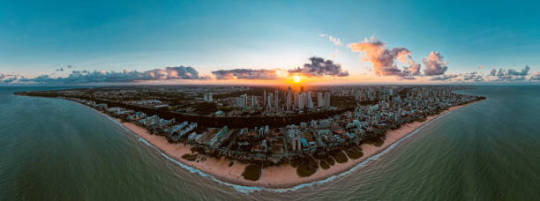
The drone photography Melbourne services are one of the most demanded services in the real estate sector. With the high advancements and innovation in technology, aerial photography helps in capturing the HD, effective and stunning visuals of property within less time. So, hire drone professionals and get quality services images, videos, or shoots of interior or exterior locations of your specific real estate property.
#Drone image & film Australia#Real Estate Drone Photography australia#drone hire melbourne#film drone#Drone videography australia
0 notes
Video
Real Estate Drone Videography or photography are the best marketing services that have the potential to attract targeted clients in a cost-effective way. The aerial shots are the ongoing trend that delivers 360-degree views of property for better clarity of indoor or outdoor views. Also, it opens up the global opportunity for the marketer to represent their commercial or residential property to potential clients at low prices spending.
#Drone image & film Australia#Real Estate Drone Photography australia#Drone videography australia#Drone photography and videography#drone hire melbourne#film drone#drone photography australia#drone photography melbourne#drone hire#Real Estate Drone Videography#Drone shots for real estate australia#drone camera melbourne
0 notes